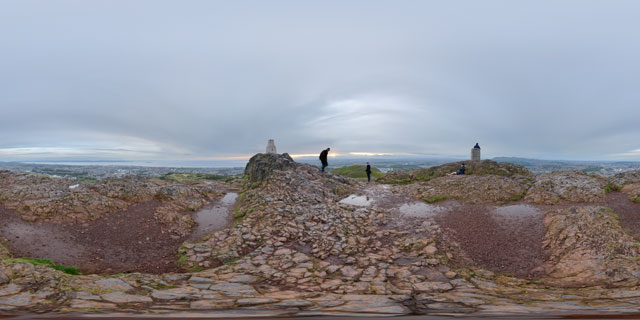
Click button below to view 360° VR interactive panorama
SD Standard definition suitable for users with slow internet connections or mobile devices or HD High definition suitable for users with fast internet connections
360° VR panorama of the centre of Arthur’s Seat in Holyrood Park, Edinburgh, Scotland. Arthur’s Seat is the main peak of an extinct volcano, rising to a height of 251 metres above sea level. The top of the peak provides excellent views of Edinburgh and the surrounding area.
Holyrood Park itself was created in 1541 when King James V of Scotland had the area enclosed with a stone wall. The park is scheduled as an ancient monument and site of special scientific interest due to its landscape, history, and wildlife.

Click button below to view 360° VR interactive panorama
SD Standard definition suitable for users with slow internet connections or mobile devices or HD High definition suitable for users with fast internet connections
360° VR panorama from a plateau on the hill at the centre of Holyrood Park, in Edinburgh, Scotland. Nearby is the peak, known as Arthur’s Seat. The hill is actually an extinct volcano, the top of which provides excellent views of Edinburgh and the surrounding area.
Holyrood Park itself was created in 1541 when King James V of Scotland had the area enclosed with a stone wall. The park is scheduled as an ancient monument and site of special scientific interest due to its landscape, history, and wildlife.

Click button below to view 360° VR interactive panorama
SD Standard definition suitable for users with slow internet connections or mobile devices or HD High definition suitable for users with fast internet connections
360° VR panorama outside the Scottish Parliament Building in Edinburgh, Scotland. The building was completed in 2004, and was designed by Catalan architect Enric Miralles. The unorthodox design of the building was developed to represent the Scottish landscape, the Scottish people and culture, and the city of Edinburgh.
The Scottish Parliament Building (Scottish Gaelic: Pàrlamaid na h-Alba, Scots: Scots Pairlament Biggin) is located in the Holyrood district of city, to the north-west of Holyrood Park. Across the road from the Parliament is The Queen’s Gallery, an art gallery located in a building that was previously used for the Holyrood Free Church.


Click button below to view 360° VR interactive panorama
SD Standard definition suitable for users with slow internet connections or mobile devices or HD High definition suitable for users with fast internet connections
360° VR panorama outside The Hub, in Edinburgh, Scotland. The building is located at the end of the Royal Mile, its Gothic spire towering over the surrounding buildings.
The Hub was originally constructed for use as a General Assembly hall for the Church of Scotland, when it was known as the Victoria Hall. It was built between 1842-5 and was designed by architects J Gillespie Graham and Augustus Pugin.
Today it is used as the home of the Edinburgh International Festival. It hosts a cafe-restaurant, two smaller rooms used for events, and the large hall, which has a capacity of 420.
Other notable buildings nearby include St Columba’s Free Church of Scotland, to the south-east. It was constructed between 1846 and 1846, and was originally named St. John’s. In 1907 the Church became the Free Church of Scotland’s Assembly Hall, and was renamed as St. Columba’s.
To the east is the Lawn Market, a continuation of the High Street. It was originally part of the High Street, until 1477 when this section of street was designated for sales of inland merchandise, such as cloth. The street was filled with stalls from a variety of sellers. Today the stalls are gone, and the Lawn Market features mostly shops aimed at tourists.

Click button below to view 360° VR interactive panorama
SD Standard definition suitable for users with slow internet connections or mobile devices or HD High definition suitable for users with fast internet connections
360° VR panorama looking out over the city of Edinburgh from Calton Hill. The hill is a famous location, both for its views, and also the variety of monuments located there.
The nearby building in this image is part of the City Observatory. The circular pillared structure to the south-west is the Dugald Stewart Monument. To the south-east is the Nelson Monument, a tower built between 1807 and 1815 in honour of Nelson’s victory at the Battle of Trafalgar.
To the east is the National Monument of Scotland. This pillared structure was built as a memorial to the Scottish soldiers and sailors who died in the Napoleonic Wars. It was intended to be modelled on the Parthenon, but was left unfinished in 1829.









